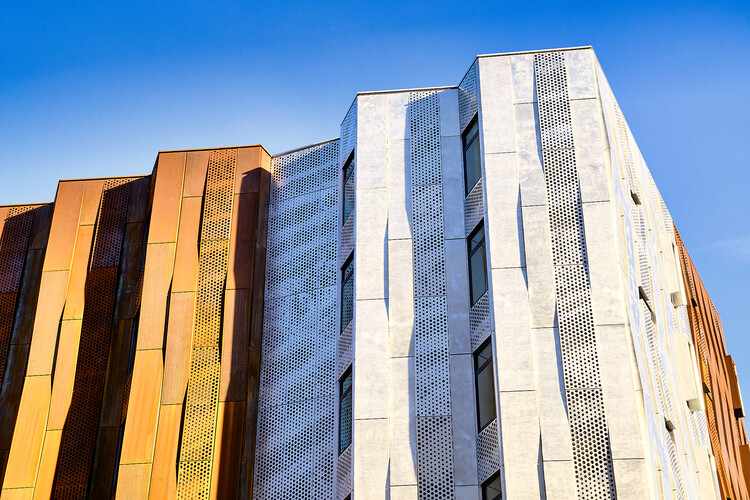Discover how cladding in construction is revolutionising building aesthetics and protection, transforming ordinary structures into architectural masterpieces
Understanding Cladding: The Protective Skin of Modern Buildings
Cladding in construction has evolved significantly over the past decades, becoming an integral component of modern architecture in the UK. At its core, cladding refers to the non-loadbearing outer layer attached to a building’s exterior structure, serving as a protective envelope while offering aesthetic appeal. This architectural element has transformed from simple weatherproofing to becoming a sophisticated system that defines a building’s character. In the UK construction industry, where weather protection is paramount, cladding has become increasingly important, with the market experiencing a 15% growth in 2023.
The Core Functions of Building Cladding
Modern cladding systems serve multiple critical functions in construction. Primarily, they create a defensive barrier against harsh weather conditions, protecting the building’s structural components from rain, wind, and UV radiation. In the UK’s variable climate, this protection is essential for maintaining building integrity. Additionally, cladding provides significant thermal insulation, helping to reduce energy consumption by up to 25-30% in many cases. The system also contributes to noise reduction, particularly beneficial in urban environments where sound pollution is a concern. Beyond these practical benefits, cladding plays a crucial role in defining a building’s aesthetic appeal, allowing architects to create distinctive designs that enhance the urban landscape.
Popular Cladding Materials and Their Applications
Traditional Materials
- Brick Cladding: Offers durability and traditional aesthetics, popular in UK residential construction
- Stone Cladding: Provides natural beauty and longevity, commonly used in high-end developments
- Timber Cladding: Delivers sustainability and warmth, ideal for both modern and traditional designs
Modern Solutions
- Aluminium Composite Panels: Lightweight and versatile, suitable for contemporary commercial buildings
- Glass Curtain Walls: Creates sleek, modern appearances while maximising natural light
- Steel Cladding: Offers strength and durability, popular in industrial applications
Innovative Materials
Recent developments have introduced groundbreaking materials like self-cleaning photocatalytic panels and bio-based composites. These innovations focus on sustainability and enhanced performance, with some new materials showing up to 40% better thermal efficiency compared to traditional options.
Installation Methods and Best Practices
Proper installation is crucial for cladding performance and longevity. The rainscreen principle, widely adopted in UK construction, creates a ventilated cavity between the cladding and building structure. This approach has shown to reduce moisture-related issues by up to 75%. Key installation considerations include:
- Ensuring proper ventilation gaps and drainage paths
- Installing appropriate moisture barriers
- Using compatible fixings and support systems
- Maintaining consistent joint spacing
- Following manufacturer specifications precisely
Safety Considerations and Regulations
Following the Grenfell Tower tragedy, the UK has implemented stringent regulations regarding cladding safety. The Building Safety Act 2022 has introduced comprehensive requirements for external wall systems, particularly for high-rise buildings. Key regulations now mandate:
- Non-combustible materials for buildings over 18 metres
- Regular safety assessments and certifications
- Enhanced fire resistance testing
- Detailed documentation of all cladding components
Energy Efficiency and Sustainability
Modern cladding systems play a crucial role in achieving energy efficiency targets. Well-designed cladding can reduce heating costs by up to 35% and help buildings achieve better EPC ratings. The latest sustainable cladding solutions incorporate recycled materials and focus on:
- Enhanced thermal performance
- Reduced carbon footprint
- Recyclability and end-of-life considerations
- Integration with renewable energy systems
Maintenance and Longevity
Proper maintenance is essential for maximising cladding lifespan and performance. Different materials require specific maintenance approaches, but general best practices include regular inspections, cleaning, and prompt repairs. Well-maintained cladding can last 30-50 years, depending on the material type and environmental conditions.
Making the Right Choice: Selection Criteria
Selecting appropriate cladding requires careful consideration of multiple factors:
- Building type and location
- Local planning requirements
- Budget constraints
- Environmental conditions
- Maintenance requirements
- Aesthetic preferences
Future Trends in Building Cladding
The future of cladding is being shaped by technological advances and environmental concerns. Emerging trends include:
- Smart cladding systems with integrated sensors
- Self-healing materials
- Energy-generating cladding panels
- Advanced sustainable composites
Expert Tips and Professional Advice
Industry professionals recommend focusing on long-term value rather than initial costs. Key considerations include:
- Investing in high-quality materials for better longevity
- Ensuring proper ventilation design
- Working with certified installers
- Regular maintenance scheduling
- Keeping detailed documentation
Conclusion: Transforming Buildings Through Effective Cladding
Cladding continues to evolve as a crucial element in modern construction, offering both practical benefits and aesthetic possibilities. As the industry advances, the focus on safety, sustainability, and performance will drive innovation in cladding systems. For successful implementation, consider working with experienced professionals and staying informed about the latest regulations and technologies. The right cladding solution can significantly enhance a building’s value, performance, and appearance while ensuring long-term protection and efficiency.
FAQ
What are the dangers of cladding?
The risks of using combustible materials in facade cladding Combustible materials can add to the spread of smoke during a fire and increase the risk of spreading to another floor or room. Thus, the fire can spread and escape routes become impassable, trapping inhabitants in the building.
What are the benefits of cladding a wall?
Increased Durability: Wall cladding protects your walls from moisture, scratches, and other types of damage, prolonging the life of your walls. Improved Insulation: Depending on the material, cladding can help with thermal and sound insulation, keeping your home cooler in summer and warmer in winter.
What are the most problems with exterior cladding involve?
The main problem with EIFS cladding is moisture retention, leading to mould growth, wood rot, and structural damage if water gets trapped behind the system. Unlike traditional stucco, EIFS does not naturally allow moisture to escape, making proper installation and maintenance crucial to prevent failures.
Why is cladding a problem?
Mould and mildew growth are among the most common problems faced by both commercial and domestic property owners. These fungi thrive in moist environments and can quickly spread across the cladding surface.
What does cladding look like?
Cladding can be made of any of a wide range of materials including wood, metal, brick, vinyl, and composite materials that can include aluminium, wood, blends of cement and recycled polystyrene, or wheat/rice straw fibres. Materials used for cladding affect vulnerability to fire.
Sources
[1] https://en.wikipedia.org/wiki/Cladding_(construction)
[2] https://ams-wa.com/what-is-cladding-in-construction-we-can-answer-that/
[3] https://picagroup.com.au/article/cladding-basics-what-is-it-and-why-is-it-important/


Leave a Reply